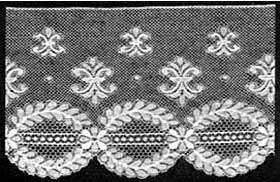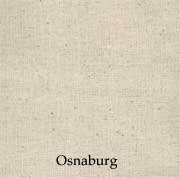Nainsook. Fine, soft-finished white cotton fabric with a polish on one side. Lighter in weight than longcloth, more highly finished; not so closely woven as cambric but heavier than batiste. Sometimes mercerized and schreinerized. A fine nainsook may be called a coarse batiste. Uses: infants' wear, lingerie. Weave—plain. Width, 36", 45", usually 36".
Nap. Not to be confused with pile. The downy or fuzzy appearance of cloth produced by raising the fibres to the surface as in outing flannel.
Napery. General term for table linen.
Net. Originally all nets and laces were made with a needle or with bobbins. Modern nets have the same effect made by machinery.
1. Blonde. Washable cotton net for curtains, linings
and ruffles. Same construction as bobbinet net, but
usually finer. White, ecru or flesh.
2. Bobbinet net is machine-made of cotton or silk yarns
partially twisting around each other so as to produce
hexagonal meshes. They appear round at a distance.
Finer grades of bobbinet used for dresses and trimmings. Uses: curtains, linings, trimmings. White or colors. Width, 36", 54", 72".
3. Cable net has a coarse mesh. Not so satisfactory for curtains as bobbinet because it stretches when laundered. Not much used at present.
4. Filet net has square spaces and imitates hand-made filet made by knotting the thread at the corners.
5. Novelty nets for curtains show a variety of effects.
Weave—novelty net or lace. Width, 36", 40", 45",
72".
6. Net, silk for evening gowns. May be soft or finished with a dressing. White, black and all colors. Uses: evening gowns, trimmings. Weave—net. Width, 72",
7. Point d' Esprit white cotton net with small dots scattered over the surface in snowflake effect. Width, narrow as footing or 72".
Nitro-cellulose. See Rayon.
Noils. Short fibres which come from the combing process in preparing yarns as for worsted. Short wool fibres are wool noils. There are silk noils, ramie noils, cotton noils.
Non-Flam. Process for making cotton goods non-inflammable, invented by William H. Perkin, Manchester, England. Non-Flam not on the American market.
Non-run or non-ravel top. Some hose made with device near top to prevent runners from going into leg of hose.
Nottingham. Type of machine-made lace or lace curtains. Originally made in Nottingham, England.

Novelty fabrics. Large class of materials particularly suitings, made to meet a style demand. They have not become staple.
Nub yarn. Fancy yarn having nubs or knots at intervals made by twisting one yarn about another forming lumps or knotty places, as ratine yarns.
Nun's veiling. Originally made in black only and used for nuns' veils. Soft, light-weight fabric similar to voile, but closer and softer. Worsted yarns, also made in silk. Piece-dyed. Wears well. Uses: dresses, negligees.
Olive drab. Called O. D. official color for U. S. army uniforms; same as Khaki.
Oilcloth. Cotton fabric coated with a preparation of linseed oils and pigments. 1. Floor oilcloth made on a burlap base, treated with linseed oil, ochre and other pigments. Printed, varnished. 2. Table oilcloth has a foundation of muslin treated with oil, turpentine and amber. May be printed. Soft pliable oilcloth gives better wear than a stiff brittle one. Smooth, dull or pebbled finish. Plain or napped back. White, black, green or printed. Uses: table and shelf coverings, rain hats, dress trimming. Weave—plain. Width, 45", 54".
Oiled silk. Thin silk soaked in boiled linseed oil and dried. Waterproof and fairly pliable. Surgical uses.
Opera hose. Women's hose of extra length.
Organdy or organdie. Thin, transparent, wiry muslin made of fine cotton yarns. White, piece-dyed or printed. The best grades are finished to retain their crispness and transparency after washing. Crushes or musses but is easily pressed. Uses: dresses, neckwear, trimmings. Orinoka* Trade name for drapery fabrics. See Sunfast
materials.
Osnaburg, Originally from Germany. Strong unbleached cotton bagging similar to heavy muslin. Kind of crash used for cement bags and for sacks in cotton fields, also for coarse clothing. Weave—plain. Width, 32".

Ottoman. Heavy corded silk fabric having larger and rounder ribs than faille. Ribs or filling usually cotton which is completely covered by warp. Yarn-dyed. Uses: coats, trimmings. Weave—plain. Width, 36", 40".

Outing flannel. Soft, light-weight cotton fabric napped on both sides, highly inflammable, soils readily, nap wears and washes off. White, solid colors and striped (yarn-dyed). Daisy Cloth* is a trade name for a kind of twilled outing flannel. Uses: sleeping garments, children's underwear, interlinings. Weave—plain or twill. Width, 27", 32", 36".
Oxford Gray. Any fabric, woven or knitted, of black and white mixed yarns.
Oxford suiting or shirting. A variety of coarse weaves, mostly basket, in mercerized cotton; true Oxford has basket weave. Heavy grade suitable for suits and skirts, lighter weight for shirts. White, colors or stripes. Weave—-basket or twill, Width, 32", 36".
PREVIOUS ---------- NEXT |



